Resene DIY project #13
From how to paint like a professional - training videos and project sheets
Resene Timber and Furniture Gel has been developed to enhance and protect outdoor timber furniture. It may also be used on timber doors and windows that are protected from the worst of the sun's damaging UV light.
Resene Timber and Furniture Gel is thicker than most stains to minimise drips and splatter. It is designed to be applied annually or biannually depending on exposure, with horizontal surfaces such as the tops of tables requiring more regular re-application and maintenance than vertical surfaces.
| View video |

How to rejuvenate outdoor furniture with Resene Timber and Furniture Gel
Determine the best sequence to apply Resene Timber and Furniture Gel. Start with table legs and rails before finishing with the tabletop. Depending on the size of the table either work across the table from the furtherest side, completing one or two lengths before working back across the table or for larger tables begin in the centre and complete one half at a time. Adopt a similar approach with outdoor chairs.
Use a good quality brush, we recommend the 63mm PAL Legend. It is ideal for most tables and chairs.
Ensure you have to-hand clean, lint-free cotton cloths. An old cotton t-shirt cut into 6-8 pieces is ideal.
While Resene Timber and Furniture Gel has minimal splatter and is unlikely to drip, it is still good practice to protect surfaces such as decking and paving with a dropcloth.
A wide variety of timbers are used for outdoor furniture and range from very dense hardwoods through to the softer timbers including pine. The surface of new hardwoods in particular can be so dense that penetration of stains into them is significantly curtailed. It is for this reason that we recommend that hardwoods be left for 8-12 weeks to naturally weather and for the grain to open-up somewhat.
Note 1: Some hardwoods notably kwila, exude tannins for many weeks as the furniture weathers. The tannins can stain concrete and pavers. It is advisable to consider where the furniture is placed initially as a result to avoid damaging surfaces.
Note 2: Tannin staining on concrete can be removed using Resene Moss & Mould Killer diluted 1:1 with fresh water.
Treat old, weathered and/or previously unstained timber furniture for moss and mould using Resene Moss & Mould killer.
Use a garden sprayer to saturate the timber surface using a 1:3 mix of Resene Timber and Deck Wash and fresh water. Avoid direct sunlight and ensure the surface remains damp for approximately 15 minutes. Lightly reapply if needed.
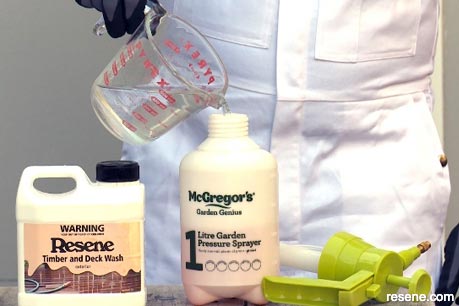
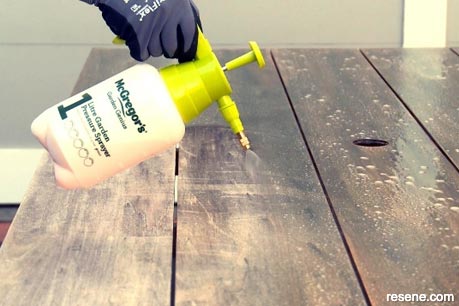

Scrub using a short-bristled scrubbing brush and fresh water to remove mould and other detritus. Working in smaller, more manageable areas is advised to ensure the Resene Timber and Deck Wash does not dry out as it can be difficult to remove once dried.
Once complete rinse thoroughly with fresh water and allow to dry. Lightly sand any 'furred' timber or marks
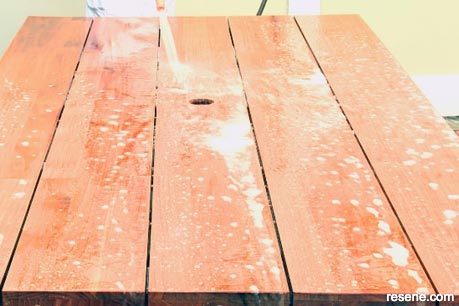

Note 3: Resene Timber and Deck Wash can mark or discolour some painted and powder coated surfaces if left to sit and dry. Rinse table legs and other metal elements with fresh water to avoid this occurring.
For previously stained furniture the preparation required will depend on the type of stain or coating and its condition. A thorough sand to remove the surface coating may be needed. In most cases if a penetrating stain was previously applied scrubbing using Resene Timber and Deck Wash as you would for weathered timber above should suffice.
Note 4: To assess the state of the previous stain splash clean water onto it - if the water beads up, the stain will need to be stripped/sanded back to bare or allowed to undergo further weathering. Stains will not penetrate through an existing stain layer that allows water to bead on its surface.
In most cases, if a penetrating stain was previously applied, scrubbing using Resene Timber and Deck Wash as you would for weathered timber should suffice. However, the water splash test should still be used.
Load a good quality brush with Gel stain by dipping into the can before lightly wiping off excess.
Apply a generous amount of Resene Timber and Furniture Gel to the timber taking care to avoid double lapping when applying to the edges of timber boards. Depending on the weather conditions, allow Resene Timber and Furniture Gel to 'sit' for 4-5 minutes, allowing it to achieve good penetration into the timber without the surface drying or tacking off. Double lapping typically results in darker, uneven patches on the timber.



Using a clean lint free cotton cloth, wipe flat surfaces in a circular motion. This helps work Resene Timber and Furniture Gel into the timber. Then lightly wipe along the timber to remove any circular marks. Allow to dry for 2 hours.
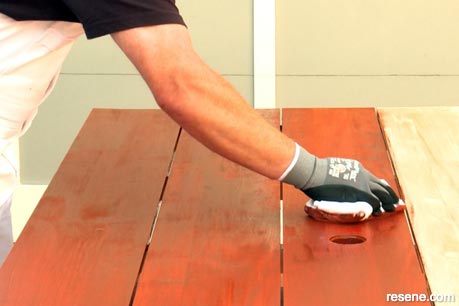

If needed, apply a second thinner coat, using the process described above but allowing it to 'sit for a shorter period of approx. 2-3 minutes again depending on weather conditions (thinly applied coats will dry quicker)
Note 5: Thinner applications, applied annually or biannually are preferable to thicker film builds, which can result from applying Resene Timber and Furniture Gel too heavily or in multiple coats. This can result in flaking where Resene Timber and Furniture Gel is not able to penetrate the timber. Tabletops where water can pond are more susceptible to this.
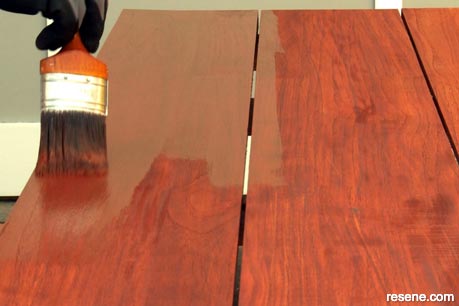

Note 6: The colour used in the video and the accompanying photos is Resene Kwila.
Training Videos and Project Sheets
Learn how to prepare surfaces and apply paint to get the best from your paint finish with these handy videos and project sheets.